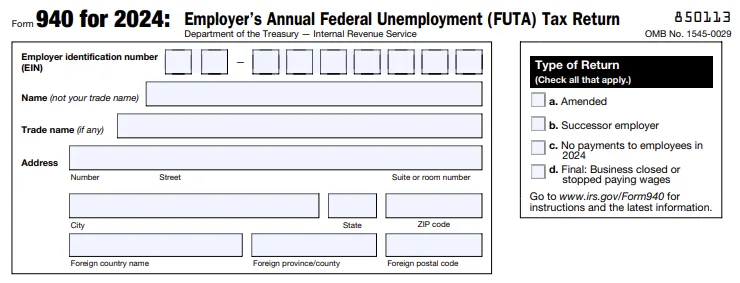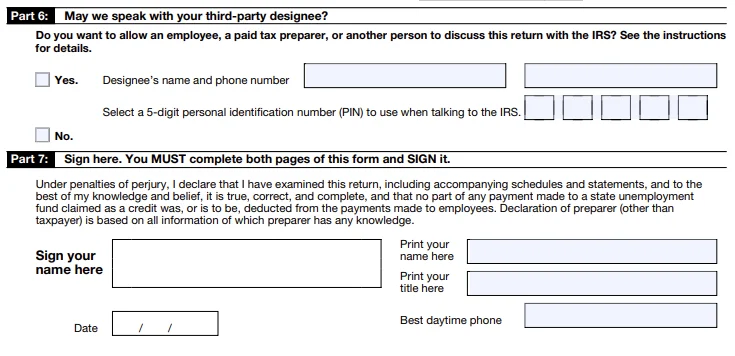Form 940 Instructions for 2024
There are seven sections to complete on Form 940. This article contains Form 940 instructions to guide you through the filing process
Charles Hardy | Last Updated: March 10, 2025
Managing payroll for your business just got easier—TaxBandits now offers it for FREE! Get started today
Share this article
Instructions for Form 940
- Part 1 - Answer questions applicable
- Part 2 - Determine your FUTA tax before adjustments
- Part 3 Determine your adjustments
- Part 4 - Determine your FUTA tax and balance due or overpayment
- Part 5 - Report your FUTA tax liability by quarter (If applicable)
- Part 6 and Part 7 - Third-party Designee and Signing Information
- How to file 940 for your business
- Home
- Payroll Forms
- IRS Form 940 Instructions
IRS Form 940 Instructions for 2024
If you are an employer, you are required to complete and file Form 940 annually. Learn how to fill out Form 940 with step-by-step instructions to avoid significant mistakes and penalties.
Form 940 consists of two pages, divided into seven parts. Firstly, complete your business information which includes your Employer Identification Number (EIN), name, trade name, and address. Also, choose the type of return which applies to your business.

Type of Return
At the top of your Form 940, check the box to indicate which type of return you’re filing.
- a. Amended: If you are filing this to correct a return that you previously filed, check ‘box a.’
- b. Successor employer: If you are a successor employer, check ‘box b’.
- c. No payments to employees in 2024: If you're not liable for FUTA tax because you haven’t paid your employees during the 2024 tax year, check ‘box c.’
- d. Final: Business closed or stopped paying wages: If this is a final return because your business is closed or stopped paying wages and you won't be filing Form 940 in the future, check ‘box d.’
Part 1 - State Unemployment Tax Information

In Part 1 of Form 940, you are required to enter information about your return. If there is a line that does not apply to your business, leave it blank.
- Line 1a - Enter the state abbreviation on line 1a if your business pays unemployment tax.
- Line 1b - Check the box if you are a multi-state employer who paid unemployment taxes in more than one state. You are required to complete and attach 940 Schedule A.
- Line 2 - Check the box, if you paid wages in a state that is considered a credit reduction state. The credit reduction states for the 2024 tax year are California, Connecticut, New York, and the US Virgin Islands. Check out our article to learn about credit reduction states for prior tax years.
Part 2 - Determine Your FUTA Tax Before Adjustments

In Part 2 of Form 940, you will be determining your FUTA tax before adjustments. If any lines don't apply to your business, skip them.
- Line 3 - Enter the total payments to all of your employees, even if not all of the payments aren’t subject to FUTA taxes.
-
Line 4 - Enter any payments that are exempt from FUTA taxes. For example, the payment doesn’t fit the definition of wages. Check each of these that apply:
- (4a) Fringe benefits
- (4b) Group-term life insurance
- (4c) Retirement/Pension
- (4d) Dependent care
- (4e) Other
- Line 5 - Enter any payments made to an employee over $7,000 (excess wages). The FUTA wage base is $7,000, this means that any amount beyond the wage base is not subject to FUTA taxes. Subtract any payments that were exempt from FUTA taxes from this amount.
- Line 6 - Enter the subtotal. Add the amounts on Lines 4 and 5 and enter the total on Line 6.
- Line 7 - Enter the total taxable FUTA wages. To get this amount, subtract Line 6 from Line 3 and enter the result on this line.
- Line 8 - Enter the FUTA tax before adjustments. To get this amount, multiply Line 7 by 0.006.
Part 3 - Determine Your Adjustments

In Part 3, you will be determining your adjustments. Only complete the lines that apply to your business.
- Line 9 - If you have excluded all taxable FUTA wages from state unemployment taxes, multiply line 7 by 0.054. Then, proceed to Part 4 (line 12).
- Line 10 - Complete line 10 if some of the taxable FUTA wages you have paid were excluded from state unemployment taxes or if you paid any of your state unemployment taxes late. If any one of these applies to your business, you are required to complete the worksheet. Enter the amount from line 7 of the worksheet.
- Line 11 - If credit reduction applies, complete Line 11 as well. Enter the total from Form 940 Schedule A here.
Part 4 - FUTA Tax and Balance Due or Overpayment

In Part 4, you will be determining your FUTA tax balance due or if you overpaid.
- Line 12 - Enter the sum of lines 8, 9, 10, and 11. Please note that if the amount on Line 9 is greater than zero, Lines 10 and 11 must be zero.
- Line 13 - Enter your FUTA deposits for the year on Line 13. Include any overpayments applied from the previous year.
- Line 14 - You will calculate the balance due. If the amount on Line 13 is smaller than the amount on Line 12, enter the difference on Line 14.
- Line 15 - If Line 13 is greater than Line 12, enter the difference on Line 15, this is the overpayment. Check the box to apply the overpayment to a later return or to receive a refund.
Part 5 - FUTA Tax Liability by Quarter

You only need to complete Part 5 of Form 940 if the amount you entered on Line 12 is more than $500; otherwise, skip this part and move to Part 6.
-
Line 16 - Enter your FUTA tax liability (not deposits) for each quarter
- 16a (Quarter 1) - January 1 to March 31
- 16b (Quarter 2) - April 1 to June 30
- 16c (Quarter 3) - July 1 to September 30
- 16d (Quarter 4) - October 1 to December 31
- Line 17 - Enter the total FUTA tax liability for the year by adding up the amount from each quarter.
With these Form 940 instructions, you can easily file Form 940.
Part 6 and 7 - Third-party Designee and Signing Information

After you've completed the sections above, you are required to sign Form 940. For more information about who is authorized to sign the return, click here.
Paid Preparer Use Only
A paid preparer is someone who is responsible for your Form 940 filing and preparing payroll tax forms on your behalf. If your form is prepared by the paid preparer, enter their information, such as name, signature, address, PTIN, and
contact number.

Signature Process Made Simple with TaxBandits!
With TaxBandits, you can use your IRS-assigned Online Signature PIN, or alternatively, you can use
Form 8453-EMP to e-sign your return.
How to file 940 for your business?
The IRS provides two methods to file your Form 940. You can either complete the form electronically or mail it to the IRS. If you choose to mail your return, ensure that you send your return to the correct Form 940 mailing address. However, the IRS recommends a faster and more secure method of e-filing of Form 940.
TaxBandits, an IRS-authorized e-file provider, offers a convenient solution to e-file Form 940. With TaxBandits, e-filing is simplified through built-in 940 instructions, automatic tax calculations, internal error checks based on IRS business rules, and the inclusion of all necessary worksheets and attachments.
Click here to learn how TaxBandits make your 940 filing simpler.